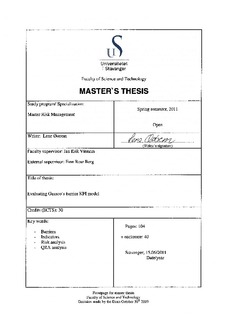| dc.description.abstract | Gassco has developed a barrier KPI model. After some use, there was a need to evaluate the model. Delimitations have been made, and the aim with this report was to answer the following questions:
1. Does Gassco‘s barrier KPI reflect learning from recent major accidents, or should more indicators be included in the model?
2. Do changes in the barrier KPI model equal changes in the risk level?
3. Is the information regarding failure rate in the model presented in an adequate way?
The answers were mainly sought by studying a selection of previously major accidents, work done in other industries in regards to these subjects and performing sensitivity calculations in the model. The methods have limitations, but in a practical view they all seemed reasonable and they could all be performed within the given time period of this thesis.
Similarities in several major accidents that have occurred in the time period 1998 – 2010 are that the underlying causes can all be addressed as management elements. These elements should be presented better in the barrier KPI model. Since Gassco’s management is located at Bygnes, the model should implement an indicator placing Bygnes at the barrier KPI chart. This indicator should represent several management elements dealt with by the management in Gassco, as well as the work done to prevent a major accident within Gassco’s portfolio.
Implementing an indicator is not enough if the aim is to learn from previous major accidents. More effort must be put in trying to manage human factors; to have a `human factor manager`, develop a data base with experience data regarding human failures and work towards implementing the key element of a high reliability organisation.
The barrier KPI model does not reflect changes in the risk level sufficient enough to be used as an indicator reflecting the risk level at a given installation. To improve the risk management in the organisation, the aim must be to have an updated risk overview at all times at a given installation. Work and effort in developing an experience database on human factors will give a hug benefit when developing a new QRA model, which take into account dependencies between barriers and changes in the failure rate. Also, the work done with the barrier KPI model will become useful. This should be the ultimate goal in the industry should be to have a more dynamic QRA model. A lot can be learned from the work done in the nuclear industry regarding human factors and in building a more dynamic QRA model. Such a model could give a risk indicator and a risk graph updated on a regular basis. This would give important information when trying to manage the risk within Gassco’s portfolio.
As of today, the failure rate of safety critical equipment is displayed as a 12 month moving average in the model. To calculate the trend, prevailing reporting period is compared up against the previous, to determine whether or not the failure rate stays unchanged or decreased/increased. The requirement to the failure rate is based on a probability distribution, and a 12 month moving average does not contain enough data to give a “correct” picture of the failure rate. Changing the presentation of the failure rate to include all reported data in the model will give a more correct basis of comparison. One should use the Bayesian approach when aggregating the data, then it will make more sense to compare the failure rate to the requirement even if there are few reported data available. Presenting the trend as a comparison between the failure rate reported the last 24 months and the aggregated value, will ensure sensitivity in the model. | en_US |
